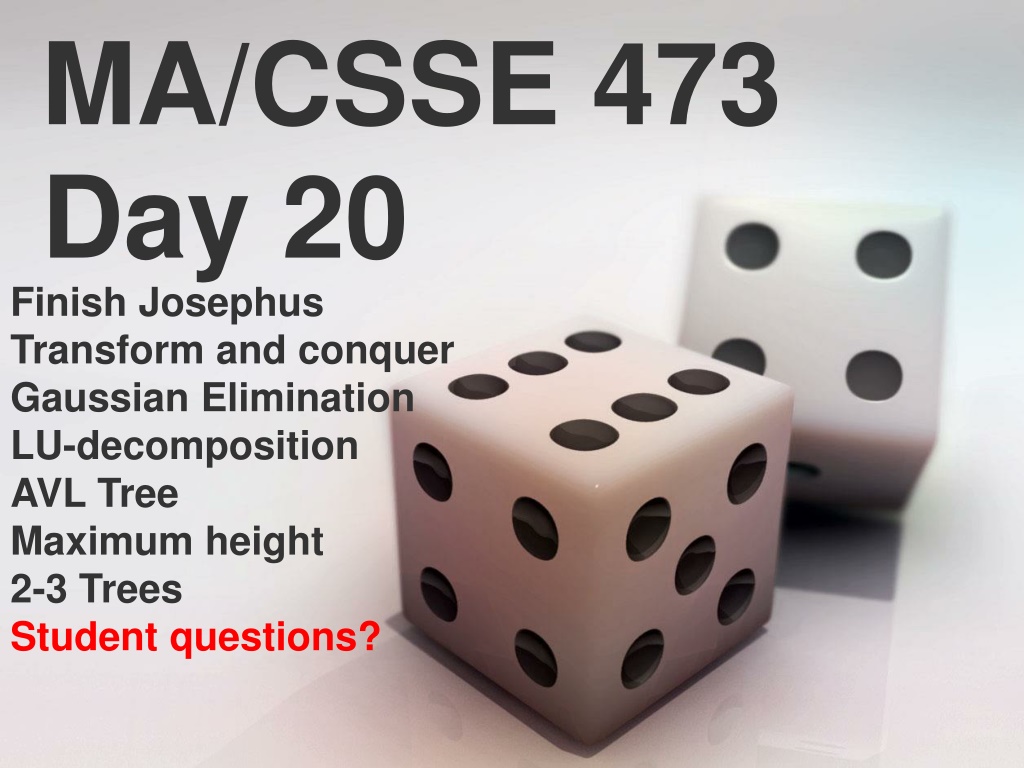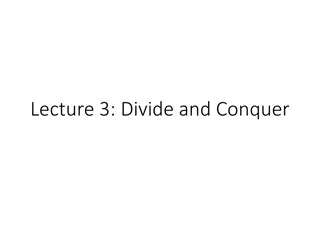Understanding Transform and Conquer Algorithms
Exploring the Josephus problem, Gaussian elimination, instance simplification techniques, and how problems can be transformed and conquered. Learn about pre-sorting arrays, solving linear systems, and simplifying complex problems through transformation techniques in computer science.
Download Presentation

Please find below an Image/Link to download the presentation.
The content on the website is provided AS IS for your information and personal use only. It may not be sold, licensed, or shared on other websites without obtaining consent from the author. Download presentation by click this link. If you encounter any issues during the download, it is possible that the publisher has removed the file from their server.
E N D
Presentation Transcript
MA/CSSE 473 Day 20 Finish Josephus Transform and conquer Gaussian Elimination LU-decomposition AVL Tree Maximum height 2-3 Trees Student questions?
Recap: Josephus Problem n people, numbered 1-n, are in a circle Count starts with 1 Every 2nd person is eliminated The last person left, J(n), is the winner Examples: n=8, n=7 J(1) = 1 Solution if n is even: J(2k) = 2*J(k) - 1 Solution if n is odd: J(2k+1) = 2*J(k) + 1 Use it to find J(2) J(8) Clever solution: cyclic bit shift left
Transform and Conquer Algorithms Transform a problem to a simpler instance of the same problem instance simplification Transformation to a different representation of the same instance representation change Transformation to an instance of a different problem that we know how to solve problem reduction
Instance simplification: Presorting an Array The following problems are simplified by pre- sorting the array: Search (can do Binary or Interpolation search) Determine whether the array contains duplicates Find the median of the array Find the mode of the elements of the array The most frequently-occurring element A related problem: Anagrams In a large collection of words, find words that are anagrams of each other How can pre-sorting help? Sort the letters of each word Interval union problem from early part of PLC course
Instance Simplification: Gaussian Elimination (hopefully you saw basics in a DE or lin. Alg. course) Solve a system of n linear equations in n unknowns Represent the system by an augmented coefficient matrix Transform the matrix to triangular matrix by a combination of the following solution-preserving elementary operations: exchange two rows multiply a row by a nonzero constant replace a row by that row plus or minus a constant multiple of a different row Look at the algorithm and analysis on pp 207-208; if you can't understand them, ask in my office. (n3) [previous HW problem]
Other Applications of G.E. Matrix inverse Augment a square matrix by the identity matrix Perform elementary operations until the original matrix is the identity. The "augmented part" will be the inverse More details and an example at http://en.wikipedia.org/wiki/Gauss- Jordan_elimination
Other Applications of G.E. Determinant calculation Calculation of the determinant of a triangular matrix is easy What effect does each of the elementary operations have on the determinant value? exchange two rows multiply a row by a nonzero constant replace a row by that row plus or minus a constant multiple of a different row Do these operations until you get a triangular matrix Keep track of the operations' cumulative effect on the determinant
LU Decomposition This can speed up all three applications of Gaussian Elimination Write the matrix A as a product of a Lower Triangular matrix L and an upper Triangular matrix U. Example: 12 144 25 5 1 Splitting A up into L and U is an n3 operation. https://rosettacode.org/wiki /LU_decomposition A = 64 8 1 1 1 0 0 25 5 1 L U = = 0 8 . 4 . 1 56 . 2 56 1 0 0 0 7 . 0 . 5 76 5 . 3 1
Review: Representation change: AVL Trees (what you should remember ) Named for authors of original paper, Adelson-Velskii and Landis (1962). An AVL tree is a height-balanced Binary Search Tree. A BST T is height balanced if T is empty, or if | height( TL ) - height( TR ) | 1, and TL and TR are both height-balanced. Show: Maximum height of an AVL tree with N nodes is (log N) How do we maintain balance after insertion? Exercise for later: Given a pointer to the root of an AVL tree with N nodes, find the height of the tree in log N time Details on balance codes and various rotations are in the CSSE 230 slides that are linked from the schedule page. Let's review that together
Representation change: 2-3 trees Another approach to balanced trees Keeps all leaves on the same level Some non-leaf nodes have 2 keys and 3 subtrees Others are regular binary nodes.
2-3 tree insertion example More examples of insertion: http://www.cs.ucr.edu/cs14/cs14_06win/slides/2- 3_trees_covered.pdf http://slady.net/java/bt/view.php?w=450&h=300 Add 10, 11, 12, to the last tree
Efficiency of 2-3 tree insertion Upper and lower bounds on height of a tree with n elements? Worst case insertion and lookup times is proportional to the height of the tree.
2-3 Tree insertion practice Insert 84 into this tree and show the resulting tree
2-3 Tree insertion practice Insert 84 into this tree and show the resulting tree























